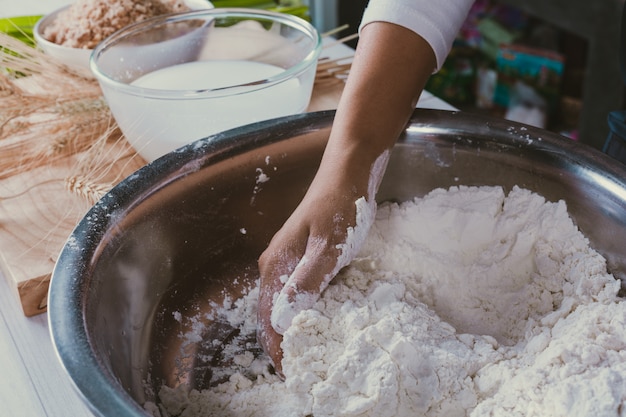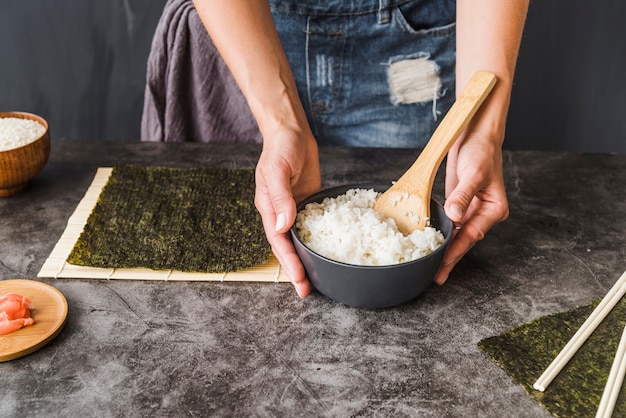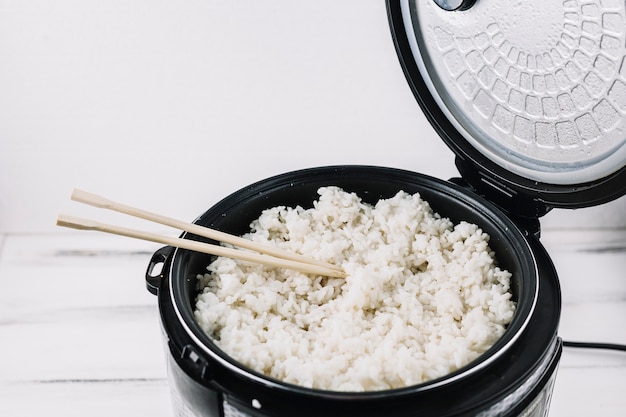Let's be honest, cooking rice can be a bit daunting, especially for beginners. You've got the whole "water-to-rice ratio" thing, the simmering time, and the dreaded mushy rice scenario. But fear not, my fellow food enthusiast! I'm here to demystify the art of rice cooking and guide you towards that perfectly fluffy, delicious pot of goodness. I've been there, struggled with soggy rice, and even tried to salvage a few disasters. But, through trial and error, I've learned a thing or two, and now I'm ready to share my wisdom with you. So, grab your trusty saucepan, let's get our hands dirty (figuratively, of course), and embark on this culinary adventure together!
(Part 1) choosing the right rice: A Journey of Flavour and Texture

1.1 white rice vs. brown rice: A Tale of Two Grains
Imagine standing at the supermarket aisle, faced with a wall of rice options. It's like staring into the abyss, right? The first choice you need to make is between white rice and brown rice. Now, they might look similar, but they're like two completely different characters in the culinary world.
White rice, the classic, is the refined version. It's been polished to a pristine white, and while it's a familiar favourite, it's lost a bit of its natural goodness during the processing. It's lighter in texture, with a mild flavour, and cooks up quickly. It's versatile, making it perfect for stir-fries, salads, and even sweet treats like rice pudding.
Brown rice, on the other hand, is the whole grain champion. It's the unrefined version, retaining its outer bran layer, which is packed with fibre and nutrients. It has a slightly nutty flavour and a chewier texture. It takes a bit longer to cook, but it's a healthier choice, making you feel good about your dinner decisions. If you're looking for a boost of healthy goodness, brown rice is the way to go. However, if you're a texture fanatic, you might find it a bit too chewy for your liking.
Ultimately, it all comes down to your personal preference and what you're looking for in your rice. Are you craving that light, fluffy texture of white rice or the hearty, wholesome goodness of brown rice? The choice is yours!
1.2 Unveiling the Rice Family: Exploring Varieties
Now that you've decided on your rice colour, it's time to delve into the fascinating world of rice varieties. Each variety has its own unique character, from the long and slender grains to the short and plump ones. Think of it as choosing your perfect partner in crime for your culinary adventures. Here's a quick guide to some of the most popular rice varieties you'll likely encounter:
- long grain rice: This is the classic, your go-to for everyday rice dishes. It boasts long, separate grains that cook up fluffy and separate, making it perfect for stir-fries, pilafs, and rice bowls. Think of it as the all-rounder, the dependable friend you can always count on.
- medium grain rice: Slightly shorter and wider than long grain, this rice has a slightly stickier texture. It's a good choice for sushi, rice pudding, and even risotto, though arborio rice is the ultimate choice for that creamy Italian delight. It's a bit more playful, adding a touch of stickiness to your dishes.
- short grain rice: This is the short and round rice, known for its super-sticky texture. It's the king of sushi and rice balls, adding that perfect chewiness and cohesion. It's also a great choice for mochi, those adorable japanese rice cakes.
- jasmine rice: This fragrant beauty has a delicate, floral aroma and a soft, fluffy texture. It's a popular choice in Asian cuisine, particularly in stir-fries. Think of it as the elegant friend, adding a touch of fragrance and finesse to your dishes.
- basmati rice: This long-grain rice has a distinct, nutty aroma and cooks up fluffy and separate. It's a perfect choice for pilafs, biryanis, and Indian dishes, adding a touch of exoticism to your culinary journey.
Don't get overwhelmed by all these choices. For beginners, starting with long-grain white rice is a safe bet. It's readily available, affordable, and versatile. As you gain confidence in the kitchen, you can explore different varieties, experimenting with their unique flavours and textures. It's like discovering a hidden treasure trove of culinary possibilities!
(Part 2) Mastering the Ratio: Getting that Perfect Texture

2.1 The Golden Ratio: Unveiling the Key to perfect rice
You've chosen your rice; now, it's time to unravel the secret to perfect rice: the ratio. This is where many beginners stumble, ending up with either mushy rice or dry, crumbly rice. It's like a delicate balancing act, and the key is to strike the perfect harmony between rice and water.
The general rule of thumb is: for every cup of rice, you need 2 cups of water. This is the magic ratio, the recipe for fluffy rice heaven. But remember, some rice varieties might be a bit more thirsty than others, requiring a little more water. Always check the package instructions to make sure you're on the right track.
2.2 Measuring Accurately: The Foundation of Consistent Results
Here's a crucial tip, especially for beginners: ditch the spoon and use a measuring cup! Accuracy is key when it comes to cooking rice. A measuring cup ensures that your water-to-rice ratio is precise, leading to consistent results every time. It also helps you avoid overfilling the pot, which could lead to a rice-filled kitchen disaster. Trust me, it's not pretty!
2.3 The Rinse Ritual: Washing Away Excess Starch for a Perfect Texture
Now, this is where the magic happens. Rinsing your rice before cooking is a crucial step, especially if you're using white rice. It might seem like an unnecessary step, but it significantly impacts the final texture of your rice. Think of it as giving your rice a refreshing shower, washing away any excess starch.
Here's the process: fill a bowl with cold water, add the rice, and swirl it gently with your hands. The water will turn cloudy as the excess starch washes away. Keep rinsing until the water runs clear, and you'll see the rice grains become brighter. It's a simple but crucial step that will prevent your rice from becoming sticky and clumpy.
(Part 3) The Cooking Process: A Step-by-Step Guide to Rice Perfection

3.1 Choosing the Right Vessel: The Importance of the Pot
Now, you've got your rice, your water, and you're ready to cook. But wait! You need the right vessel for your rice adventure: a saucepan with a tight-fitting lid. Think of it as the home for your rice transformation, providing a secure and cozy environment for it to cook perfectly. You want to ensure the heat is distributed evenly and the steam can't escape, creating a perfect steam bath for your rice.
While different pots might work, I've found that a good old-fashioned saucepan is the best option. It's simple, reliable, and gets the job done. Plus, it's a classic kitchen staple that you'll use for countless other culinary adventures.
3.2 Getting the Party Started: Bringing the Water to a Boil
Add the rinsed rice to your saucepan and pour in the measured amount of water. Now, it's time to crank up the heat! Place the pot on the stove and bring it to a rolling boil. This is the first crucial step in the cooking process. Think of it as the "pre-heat" stage for your rice, getting it all fired up and ready to cook.
3.3 The Art of Patience: Simmering Time
Once the water is boiling, it's time to turn down the heat and let the rice simmer gently. Reduce the heat to a low simmer, cover the pot with the lid, and let the rice cook for about 15-20 minutes. This is where you need to practice patience, my friend. Resist the urge to lift the lid and peek inside. I know it's hard, especially when you're excited about your rice, but trust the process. Let the rice do its thing in peace, allowing it to absorb the water and reach that perfect texture.
3.4 The fluff test: Checking for Doneness
After 15-20 minutes, it's time to check on your rice. Gently lift the lid and take a peek. If the water has been absorbed, and the rice grains are cooked through, you're in the clear. If there's still some water left, simmer for another 2-3 minutes. To check for doneness, try the "fluff test." Take a single grain of rice between your fingers and try to fluff it gently. It should be soft and fluffy, not hard or sticky. If it's still a bit firm, give it a few more minutes to cook.
(Part 4) Resting the Rice: Letting it Breathe
4.1 The Importance of Rest: Achieving Fluffiness
Once the rice is cooked, don't rush to serve it immediately. Let it rest, covered, off the heat for 5-10 minutes. This resting period is crucial for achieving that perfect, fluffy texture. Think of it as giving the rice a chance to relax and absorb any remaining water. It's like a little spa treatment for your rice, allowing it to reach its full potential.
(Part 5) Fluffing the Rice: The Final Touch
5.1 Fluffy Rice: The Goal
After resting, it's time for the grand finale: fluffing the rice. This is the final step that transforms your cooked rice into a fluffy, delicious masterpiece. Use a fork, a rice paddle, or even your fingers to gently fluff the rice, separating the grains and creating that airy texture we all crave. It's like giving your rice a gentle massage, allowing it to breathe and release its full flavour.
(Part 6) Serving the Rice: Get Creative and Explore
6.1 Classic Accompaniments: The Usual Suspects
You've got perfectly cooked rice; now it's time to celebrate! Rice is an incredibly versatile dish, the perfect base for countless culinary creations. It pairs beautifully with various cuisines, from fiery stir-fries and rich curries to fresh salads and comforting rice bowls. Here are a few classic pairings to get your creative juices flowing:
- Stir-fries: Combine your rice with your favourite vegetables and proteins. Think chicken and broccoli, tofu and peppers, shrimp and snow peas. The possibilities are endless!
- Curries: Rice is the quintessential companion for many curries, providing a neutral base for the bold flavours. Try it with chicken tikka masala, butter chicken, or lentil curry for a truly satisfying meal.
- Salads: Add rice to your salads for a more filling and hearty meal. Try quinoa salads with chickpeas, or brown rice salads with roasted vegetables for a burst of flavour and texture.
- Rice Bowls: Create your own customizable rice bowls with various toppings. Think grilled salmon, avocado, edamame, and sriracha sauce for a delicious and satisfying meal.
(Part 7) Storing leftover rice: Keeping it Fresh and Tasty
7.1 Refrigerating Rice: The Right Way to Store
If you have leftover rice, don't fret! You can store it in the refrigerator in an airtight container for up to 3 days. Just make sure the rice has cooled down completely before storing it. This will prevent bacteria from growing and keep your rice fresh and delicious.
7.2 Reheating Rice Safely and Deliciously
To reheat your leftover rice, place it in a microwave-safe dish, add a splash of water, cover the dish, and microwave on high for 1-2 minutes, or until heated through. You can also reheat it on the stovetop by adding a few tablespoons of water to a saucepan, bringing it to a boil, and then simmering the rice for 2-3 minutes.
(Part 8) Rice cooking tips and Tricks: Mastering the Art
8.1 Tips for Perfect Rice: Making it Easy
Here are some helpful tips to ensure you achieve perfect rice every time:
- Don't overfill the pot: Leave some space at the top of the pot for the rice to expand during cooking. This will prevent it from overflowing and creating a sticky mess.
- Use cold water: Starting with cold water helps the rice cook evenly, ensuring that every grain reaches perfection.
- Don't stir the rice: Resist the urge to stir the rice while it's cooking. It can cause the rice to become mushy and sticky, ruining its fluffy texture.
- Add a pinch of salt: A pinch of salt added to the water enhances the flavour of the rice, bringing out its natural sweetness.
- Experiment with different rice varieties: Once you've mastered the basics, try different rice varieties to discover new flavours and textures. It's like embarking on a culinary adventure, exploring the diverse world of rice.
8.2 Rice cooking mistakes to Avoid: Learning from Experience
Here are some common rice cooking mistakes to avoid:
- Not rinsing the rice: This can lead to sticky rice. It's a simple step that makes a big difference.
- Using too much or too little water: Check the package instructions for the correct ratio of rice to water. Don't guess, measure it out!
- Opening the lid too early: Allow the rice to cook undisturbed for the recommended time. Give it space to breathe and transform.
- Overcooking the rice: This can result in mushy rice. Keep an eye on the cooking time and check the rice for doneness using the fluff test.
FAQs: Your Questions Answered
1. Can I use a rice cooker?
Absolutely! Rice cookers are designed specifically for cooking rice and often do a fantastic job. They're particularly great for beginners as they take the guesswork out of the cooking process. Just follow the instructions provided with your rice cooker.
2. How can I make my rice more flavorful?
There are plenty of ways to add flavour to your rice. You can try adding a bay leaf, a sprig of rosemary, or a pinch of saffron to the water while cooking. This will infuse the rice with a subtle aroma and flavour. You can also toss in a little butter or olive oil after the rice is cooked.
3. What happens if I overcook my rice?
If you overcook your rice, it will become mushy and sticky, making it difficult to enjoy. There's not much you can do to save overcooked rice. However, if the rice is slightly overcooked, it's still edible. You can try fluffing it with a fork to make it less sticky. You can also use it in dishes that require a softer rice texture, such as rice pudding or risotto.
4. Can I cook brown rice like white rice?
Yes, you can cook brown rice using the same method as white rice. However, brown rice takes longer to cook, typically 30-45 minutes. You might need to add a little extra water to brown rice as it absorbs more water than white rice.
5. What are some other types of rice I can try?
The world of rice is full of exciting varieties. Try wild rice, known for its nutty flavour and chewy texture. Or try black rice, which is very chewy and has a slightly sweet flavour. For a healthier option, try quinoa, which is a complete protein and has a similar texture to rice. The world of rice is your oyster, so go out there and explore!
There you have it, my friend. The secrets of perfect rice revealed. Don't be afraid to experiment, try new things, and most importantly, enjoy the process! Happy cooking!
Everyone is watching

Corn on the Cob: The Ultimate Guide to Perfectly Cooked Ears
Healthy MealsAh, corn on the cob. Just the name evokes images of sunny days, barbecues, and that sweet, juicy flavour that ...

Perfect Pork Roast Oven Cooking Time: A Guide to Delicious Results
Healthy MealsThere's something truly satisfying about a perfectly roasted pork. The aroma alone is enough to make your mout...

Ham Cooking Time: How Long to Bake, Smoke, or Boil a Delicious Ham
Healthy MealsAh, ham. It's a classic, isn't it? A real crowd-pleaser, especially around holidays. And when done right, it'...

Scallops: The Ultimate Guide to Perfect Cooking
Healthy MealsAh, scallops. Those delicate, sweet, and utterly delicious morsels of the sea. They hold a special place in my...

Spaghetti Squash: The Ultimate Guide to Cooking and Serving
Healthy MealsRemember that time you saw spaghetti squash at the supermarket, looking all bumpy and strange, and thought, "W...
